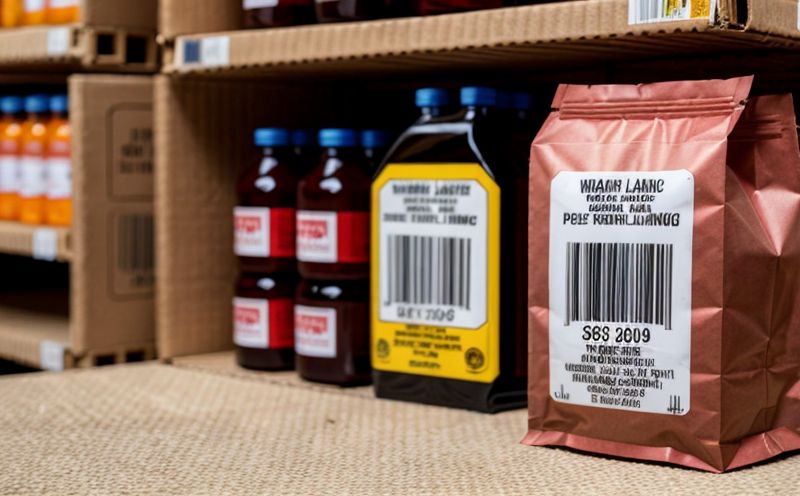ASTM F963 Label Adhesion and Print Permanence Test
The ASTM F963-17 standard covers safety requirements for toys intended for use by children under 14 years old. Within this comprehensive set of standards, the label adhesion and print permanence test is a critical component that ensures toy labels remain intact during reasonable use and do not detach or release harmful materials. This test evaluates how well the printed information on labels adheres to the surface of toys and whether the ink remains permanently legible even after exposure to various environmental conditions.
The importance of this test cannot be overstated, especially in sectors where children’s safety is paramount. It helps manufacturers ensure that critical information such as warnings, age recommendations, and instructions are not lost or obscured during playtime. This ensures compliance with international standards like ISO 8063-2:1997 which specifies methods for determining the adhesion of labels to paper.
In this test, toy labels undergo rigorous conditions designed to simulate real-world scenarios a child might encounter when handling toys. These include exposure to water, abrasion, and temperature changes. The aim is to assess not only the physical integrity but also the chemical stability of the label materials used in toys. This includes checking for any potential migration of hazardous substances from non-adhesive parts of the labels.
The test procedure typically involves cutting a sample piece of the toy's label according to specified dimensions and then adhering it onto a standardized backing material using an approved adhesive. After this, the label is subjected to various stress tests including immersion in water for a set duration, mechanical abrasion by rubbing against a rough surface, and exposure to high temperatures. Once these tests are completed, the adhesion force required to remove the label from its base material is measured.
The print permanence aspect of this test focuses on ensuring that the printed content remains clear and readable after undergoing similar environmental stressors as those experienced by the toy during normal use. This involves evaluating the resistance of ink colors against fading due to light exposure, washing, or prolonged contact with skin oils.
Understanding these aspects is crucial for manufacturers aiming to meet regulatory requirements set forth by ASTM F963 and other relevant global standards. By conducting this test rigorously, toy producers can enhance consumer confidence in their products while minimizing risks associated with non-compliant labeling practices.
Applied Standards
The ASTM F963-17 standard specifies the performance criteria for toys intended for use by children under 14 years old. This includes requirements related to structural stability, flammability, and particularly in our context, labeling integrity.
- Astm F963 Section 8.20 provides detailed guidelines on how labels should be applied and their durability during use.
- ISO 8063-2:1997, which is referenced within ASTM F963, offers methods for determining the adhesion of labels to paper.
- IEC 62196:2015 also addresses aspects pertinent to toy labeling, focusing on electronic toys and their associated safety concerns.
These standards collectively ensure that all elements of a toy’s label, including text, images, and symbols, are not only visible but also remain securely attached throughout the expected lifecycle of the product. Compliance with these regulations is essential for manufacturers aiming to protect child welfare while maintaining market access.
Industry Applications
The ASTM F963 Label Adhesion and Print Permanence Test finds extensive application across various sectors involving toy manufacturing, including but not limited to:
- Manufacturing Plants: Ensures that labels are correctly applied according to specifications.
- R&D Departments: Used during product development stages to identify potential issues early on.
- Safety Compliance Units: Aids in verifying whether toys meet international safety standards like ASTM F963.
- Quality Control Labs: Regularly employed for batch testing prior to distribution.
- Regulatory Bodies: Often requested during inspections and audits conducted by agencies responsible for enforcing toy safety laws.
- Procurement Teams: Helps in evaluating suppliers based on their adherence to quality standards before finalizing contracts.
This testing process plays a vital role in safeguarding the well-being of young consumers by ensuring that essential information is readily accessible and remains intact during typical usage conditions. It serves as a cornerstone for maintaining high ethical standards within the toy industry.
Why Choose This Test
Selecting the ASTM F963 Label Adhesion and Print Permanence Test offers numerous advantages to businesses operating in the toy manufacturing sector:
- Enhanced Consumer Trust: By ensuring that all labels remain intact, you demonstrate a commitment to child safety.
- Avoidance of Legal Penalties: Non-compliance with ASTM F963 can lead to costly fines and damage to brand reputation. This test helps avoid such pitfalls.
- Improved Product Quality: Identifying weak points early allows for corrective measures that enhance overall product quality.
- Increased Market Access: Meeting international standards opens doors to broader markets where stringent regulations apply.
- Better Resource Management: Early detection of issues leads to more efficient use of resources during production cycles.
- Promotion of Brand Image: Demonstrating adherence to high safety and quality benchmarks can significantly boost brand image among consumers.
- Customer Satisfaction: Providing safe toys that meet all necessary standards ensures customer satisfaction and loyalty.
Incorporating this test into your quality assurance framework not only meets regulatory requirements but also contributes positively to the reputation of your company. It reflects a dedication to excellence in toy production, which is crucial for long-term success in this competitive market.





